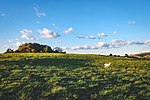Washington, West Sussex

Washington is a village and civil parish in the Horsham District of West Sussex, England. It is located five miles (eight kilometres) west of Steyning and three miles (five kilometres) east of Storrington on the A24 between Horsham and Worthing. The parish covers an area of 1,276 hectares (3,150 acres). In the 2001 census 1,930 people lived in 703 households, of whom 820 were economically active. At the 2011 Census the population of the civil parish was 1,867.The village lies at the foot of the South Downs escarpment. The Anglican parish church is dedicated to St Mary. There is one pub, the Frankland Arms, a primary school and a village hall with an adjoining sports field. The hamlet named Rock lies to the north of the A283 road.
Excerpt from the Wikipedia article Washington, West Sussex (License: CC BY-SA 3.0, Authors, Images).Washington, West Sussex
Washington Bostal,
Geographical coordinates (GPS) Address Nearby Places Show on map
Geographical coordinates (GPS)
| Latitude | Longitude |
|---|---|
| N 50.90298 ° | E -0.40634 ° |
Address
Washington Bostal
Washington Bostal
RH20 4AZ
England, United Kingdom
Open on Google Maps










